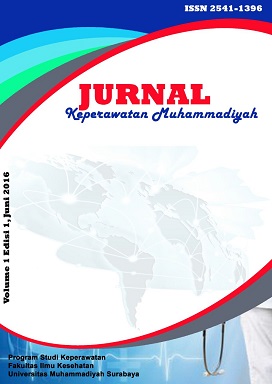STUDI DESKRIPTIF KUALITAS HIDUP PASIEN PENYAKIT GINJAL KRONIK YANG MENJALANI HEMODIALISIS DI RUMAH SAKIT PKU MUHAMMADIYAH YOGYAKARTA
Abstrak
Objective: The research purpose was described quality of life in chronic kidney disease patients at haemodialysis unit PKU Muhammadiyah hospital in Yogyakarta.
Â
Methods: This research was a descriptive study with cross sectional design using survey technique.
Â
Results: Researcher collected the research data at haemodialysis unit PKU Muhammadiyah hospital in Yogyakarta. Total of 185 chronic kidney disease patients recruited using convenience sampling. Mean age for the sample was 51.1 years (SD = 12.6). Most were 50-79 years old (n = 104, 56.2%), male (n = 113, 61.1%), low education status (n = 132, 71.4%), married (n = 172, 93.0%), living with family (n = 181, 97.8%), no employment status (n = 107, 57.8%), and patients who had haemodialysis frequency two times per week (n = 116, 62.7%). Researcher used KDQOL-36â„¢ to describe quality of life in chronic kidney disease patients. This instrument had subscales, such as: S/P (Symptom/Problem list), EKD (Effects of Kidney Disease), BKD (Burden of Kidney Disease), PCS (Physical Component Summary), MCS (Mental Component Summary). The result of S/P was 77.00 (SD = 14.15), EKD was 74.51 (SD = 13.48), BKD was 41.62 (SD = 19.98), PCS was 31.57 (SD = 5.60), and MCS was 43.91 (SD = 6.51).Â
Â
Conclusion: Chronic kidney disease patients' demographic data and KDQOL-36â„¢ subscales had contribution to determine the quality of life. Age, gender, educational status, marital status, living conditions, employment status, and frequency of haemodialysis were related aspects.Unduhan
Diterbitkan
Terbitan
Bagian
Lisensi
- Penulis tetap memegang hak atas karyanya dan memberikan hak publikasi pertama kepada jurnal ini yang secara simultan karya tersebut dilisensikan di bawah:Â Creative Commons Attribution-ShareAlike 4.0 International (CC BY-SA 4.0)









